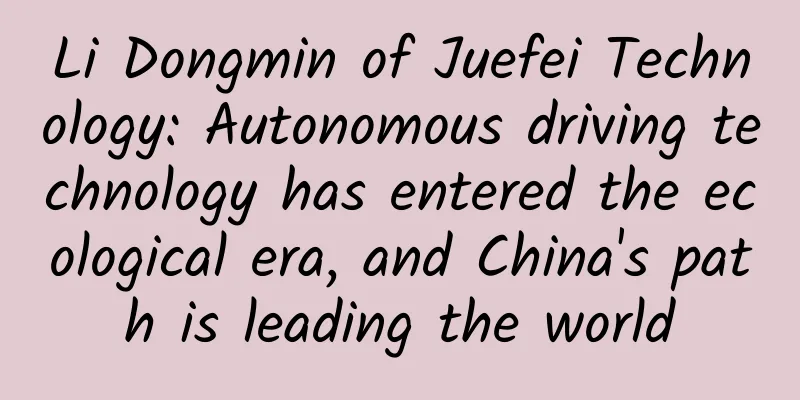Li Dongmin of Juefei Technology: Autonomous driving technology has entered the ecological era, and China's path is leading the world

|
In the past 2020, new energy vehicles that have shined in the capital market have "popularized" the concept of autonomous driving to the world. Although the systems installed in mass-produced vehicles are mostly below the L3 level, and there are still many areas to be improved in technology and law, this wave of rushing towards the future is already rolling in. As time goes by in 2021, the autonomous driving industry has frequently received capital favor. Didi Autonomous Driving received $300 million in financing led by IDG Capital, and Cruise, a subsidiary of General Motors, received $2 billion in new equity investment from investors such as Microsoft. There is no doubt that autonomous driving has indisputably become the Everest of the AI era, attracting a large number of giant companies such as Apple and Huawei to rush into the market. Just like other industries, the world is currently divided into two paths in the direction of autonomous driving: China and the United States. In terms of single-vehicle intelligence, American companies represented by Google Waymo continue to lead, but in the more promising vehicle-road collaboration, the C-V2X standard promoted by China has been widely recognized by the mainstream industry, and a large number of Chinese companies around this have thus driven onto the highway of autonomous driving. On this ever-flowing avenue of autonomous driving, as one of the few AI technology innovation companies in China that focuses on the industry, Juefei Technology has built a data service platform with "road digitization" as the core, and at the same time provides data application services for different levels of the industry. With "data fusion and innovation" as the main driving force, it has become the most well-known intelligent data operator in the field of vehicle-road collaboration. With the further deepening of cooperation between Juefei Technology and all parties in the industry, combined with the integrated hardware and software edge deployment, Juefei Technology's vehicle-road collaboration solution has also been implemented in many regions. Juefei Technology has gradually taken the lead in the industry and established a "Juefei" model for the Chinese path of autonomous driving. China’s path to autonomous driving The future of autonomous driving technology is becoming increasingly clear, but judging from the development paths of different industry participants, companies from China and the United States are each leading two different technological paths. One is the single-vehicle intelligent hardware model that focuses on improving the computing power of a single vehicle, which is dominated by Silicon Valley in the United States, such as Google Waymo; the other route is the China-led intelligent network path, which uses the form of vehicle-road collaboration (V2X) and infrastructure construction to provide large-scale implementation of smart travel. In contrast, the intelligence of a bicycle mainly relies on sensors to achieve the above functions. The disadvantage is that it will cause a large number of sensors to pile up, pushing up the cost of a bicycle. In addition, when a bicycle senses, it often forms a visual blind spot due to obstruction by the vehicle in front or road depressions and bumps, which buries safety hazards. In the current context of lack of infrastructure and industry participants fighting on their own, single-vehicle intelligence seems to have shown stronger vitality and occupies a dominant position in people's perception of autonomous driving. However, in the long run, the vehicle-road collaborative technology that uses base stations and wireless communication technology to conduct collaborative sensing between people, vehicles, and roads and provide cars with unlimited vision can not only effectively reduce the cost of smart cars and improve the safety of unmanned driving, but also is a realistic key to unlocking the future vision of smart cities. In 2017, the State Council clearly proposed "demonstration and promotion of vehicle-road cooperative technology" in the "13th Five-Year Plan for the Development of Modern Comprehensive Transportation System"; In 2020, 11 national ministries and commissions jointly issued the "Intelligent Vehicle Innovation and Development Strategy", proposing to combine 5G commercial deployment, promote the coordinated construction of 5G and the Internet of Vehicles, carry out 5G-V2X standard development and R&D verification, and promote the inclusion of the Internet of Vehicles in the national new information infrastructure construction project. The market quickly launched many responses to the policy. Between 2018 and 2020, with the implementation of 5G technology, the construction of domestic vehicle-road collaboration technology developed rapidly. Coupled with the advent of Internet of Vehicles chips and roadside sensor technology, the hardware foundation of vehicle-road collaboration gradually took shape and the pipeline construction was initially completed. "But what is being transported in the pipeline, and what is vehicle-road collaboration coordinating?" Li Dongmin, CEO of Juefei Technology, has an ultimate question about the market and technology, "When will a true vehicle-road collaboration solution appear on the market?" It was from this question that Juefei Technology positioned itself as a vehicle-road collaborative data service provider since its inception. Li Dongmin said: "Few startups decide what they will not do at the beginning of their business, but we decided not to make hardware or car control, but to focus on processing the dynamic and static data that is generated continuously, and use the data engine to drive the implementation of vehicle-road collaborative technology." Juefei Technology's goal is to create a data engine for the entire smart travel industry. On the one hand, it empowers operational scenarios through high-precision digital capabilities, and on the other hand, it provides reliable and accurate intelligent solutions through the spatiotemporal synchronization and integration of vehicle-side and road-side sensor data with high-precision maps, effectively ensuring the reliability and safety of autonomous driving vehicles. As Zhang Bian, an academician of the Chinese Academy of Sciences, said, future artificial intelligence will be a combination of knowledge-driven and data-driven. After entering the market, Juefei Technology's data engine has solved many pain points in the autonomous driving industry. For example, without relying entirely on LiDAR perception, it can synchronize LiDAR and cameras in sub-milliseconds, making up for some natural deficiencies in the single-vehicle intelligent mode. Not participating in hardware production and not competing head-on with OEMs in the field of single-vehicle intelligence has enabled Juefei Technology to have extensive and in-depth cooperation with sensor manufacturers, OEMs, and telecom service providers. Li Dongmin compared the early-stage vehicle-road collaboration industry to the Android system. Faced with an industry that is growing wildly and lacks standardization, when even the question of whether the lidar is mechanical or fixed has not yet been determined, Juefei Technology, which adheres to the creed of open cooperation, will have more possibilities than closed industry giants that tend to create "whole-family bucket" products. Juefei Technology Ecosystem As almost the only vehicle-road collaborative data service provider in the industry that focuses on data engine and service, Juefei Technology has gained unprecedentedly broad market cooperation opportunities as soon as it was born. From the leading commercial OEM Yutong Bus, to chip giants NVIDIA and Cambrian, to transportation hardware manufacturers Hikvision and Dahua and other deep participants in the vehicle-road collaboration industry, all have cooperated with Juefei Technology. The most important partner among them is China Mobile. Talking about the cooperation with China Mobile, Li Dongmin said: "The demand between vehicle-road-cloud and 5G is two-way. Vehicle-road collaboration has extremely high latency requirements. From the capture of roadside sensor data to edge data calculation and then transmission to the car receiving end, the overall time cannot exceed 100 milliseconds, leaving a maximum of 10 milliseconds for network latency. This goal can only be achieved under the 5G network. On the other hand, the 5G network with trillion-level investment also needs vehicle-road collaboration as an important use scenario for its technology implementation." Telecom operators around the world have sensed this trend. The US telecom operator AT&T has long signed a cooperation agreement with the Irish IDA and Dublin Council to jointly cooperate in the field of Internet of Vehicles; the US Verizon has also invested in the autonomous driving company Renovo in advance. Even more foresighted than the operators was Juefei Technology. Long before the concept of autonomous driving became popular, Juefei Technology boldly predicted that China's telecom operators needed Juefei's technology and the market opportunities it provided. Li Dongmin said that when China Mobile had not yet announced the RTK-related projects, Juefei Technology took the initiative to find China Mobile and provided relevant materials on autonomous driving and vehicle-road collaboration. Based on a good prediction of the market, in October 2019, after repeated technical research, Juefei Technology achieved the strict requirements of China Mobile's East China Sea Bridge Demonstration Zone project in the shortest time and with the best results. Of course, when the project passed the acceptance, Juefei also completely won the trust of China Mobile. "The photos of Juefei Technology's system interface in the Donghai Bridge project appeared in all the subsequent high-precision positioning demonstrations of China Mobile," said Li Dongmin. After this battle, Juefei Technology was invited to join China Mobile's precise positioning "Vertical and Horizontal Plan" as a partner and core founding member of China Mobile's autonomous driving solutions, and jointly carry out research on key technologies for autonomous driving in 5G environments. Figure: Juefei Technology's high-precision fusion positioning solution was demonstrated at China Mobile's 5G Autonomous Driving Summit In addition, at a time when "software-defined cars" has become an industry consensus, Juefei Technology, which is committed to becoming an intelligent data service operator, adheres to its own software strategy, actively carries out commercial cooperation with leading OEMs and Tier 1 suppliers, and forms an alliance with industry partners such as the School of Automotive Engineering and Transportation of Tsinghua University to jointly accelerate the pace of autonomous driving in the era of intelligence. Last year, Juefei Technology and Yutong Bus cooperated to launch an autonomous driving bus in Zhengzhou, Henan. Passengers only need 1 yuan to experience L4 level autonomous driving between 18 stations, which attracted a large number of curious citizens. Through the intelligent driving "data engine" platform, Juefei Technology provides Yutong Bus with an autonomous driving AR fusion system that supports fusion rendering of multi-source data, and can express the surrounding environment in various driving scenarios including vehicles, pedestrians, traffic signs, traffic light status, etc., so that users can experience autonomous driving technology in a visual way. It is reported that this is the first time in the industry that the user safety experience has been improved through software capabilities, showing more possibilities of vehicle-road collaboration in the context of the "China Path". At the same time, after launching more industrial practices for vehicle-road collaboration technology, Juefei Technology has set its sights on the commercial vehicle market. "Compared with daily passenger cars, transport vehicles in commercial scenarios such as ports and mines have a higher frequency of use and are more economical," said Li Dongmin, "Juefei can create higher value for partners through vehicle-road collaboration." In closed scenarios such as ports and mining areas, poor working conditions may cause the failure of single-vehicle sensor equipment, leading to dangerous situations. Juefei Technology can use roadside lidar and camera sensors, combined with laser point cloud, image and high-precision map data, to achieve real-time perception, recognition and tracking of vehicles, and output semantic, centimeter-level accurate positioning results in real time, combined with 5G high-speed signal transmission, so as to provide high-precision, low-latency environmental perception and positioning navigation for vehicles in these commercial scenarios. Juefei's Journey to Vehicle-Infrastructure Collaboration As a startup in the field of vehicle-road collaboration, Juefei Technology has not only carved out a path in the field of autonomous driving, which is considered a battlefield, but has also established a well-received status as a "data service operator" that has never been seen in the industry. The open platform and industry alliance ecology that it calls for and advocates have also received positive responses from a number of giants. Industry leaders such as Cambrian and Qianxun also regard Juefei as a strategic ecological partner. Why has Juefei Technology gained such a high reputation in the autonomous driving industry? I think there are two reasons: 1. Juefei Technology has an open and inclusive philosophy and a sufficiently high technological moat; 2. The industry future depicted by Juefei Technology has been highly recognized by industry partners. Juefei Technology's technical strength is unquestionable, but its towering moat is not for data hegemony, but for the various know-hows it has gained from exploring the unknowns of the industry. In addition to the various high-sounding technical terms, Juefei Technology's understanding and investment in the vehicle-road collaboration industry has opened up a thorny mountain road for the industry to move forward. For example, in response to the previous situation in which the industry was operating independently and lacked standardization, Juefei Technology has spent a lot of time and energy to adapt sensors and data of different specifications, so that lidars with different wiring harnesses and camera data of different resolutions can be recognized by chip manufacturers such as NVIDIA and Cambrian, thereby helping them gain the ability to enter the vehicle-road collaborative network. For another example, Juefei Technology analyzes, understands and learns the vast and ever-growing road-side and vehicle-side data. As you are reading this article, this data is still flowing into the database all the time, being converted into actionable data by artificial intelligence, and becoming part of the "data engine" of the entire vehicle-road-cloud industry. The so-called Know How is the process from knowing the principle to POC technical verification and then to the details. This is a long technical verification process and a field where latecomers have little advantage. Huawei Chairman Ren Zhengfei also pointed out in a recent speech that "in addition to algorithms and computing power, Know How is more important in artificial intelligence. Know How in the industry and in the hands of enterprises is the crystallization of their decades of exploration and accumulation, tens of millions of verifications, and repeated modeling, leaving behind theories and experiences." In this regard, Li Dongmin admitted that the technological moat of Juefei Technology is mainly Know How. In front of this moat, "all competitors of Juefei Technology have become potential customers", "because many manufacturers have passed the POC verification stage and entered the scale-up stage. They will find that directly using Juefei Technology's data operation services is actually the lowest risk and most reasonable option." Li Dongmin said, "Because the operating costs of AI companies are extremely high, enterprises cannot afford to lose money, and they can't even afford to keep up with the times." In addition to its outstanding product strength, Juefei Technology is also looking at the possibility of using vehicle-road collaborative technology to subvert the traditional automotive travel industry. Li Dongmin believes that in the past 20 years or even longer, although the transportation and travel industry has been called a Shura field, there has been no monopoly, and there has been no winner-takes-all situation under the network effect. "This is mainly because industry participants in the past still participated in the industry's infrastructure construction with the mindset of hardware production." Under the guidance of data integration service providers such as Juefei Technology, after network thinking is implemented throughout the industry, the efficiency of roadside sensor infrastructure will be greatly improved in the future, and the vehicle-road collaborative system will bring exponential benefit growth to the industry. Why does the country advocate vehicle-road collaboration and even regard it as infrastructure construction in the new era? One of the important reasons is that the economic benefits brought by traditional transportation construction have become increasingly limited. Unlike the high cost of traditional single-vehicle intelligence, vehicle-road collaboration can not only significantly reduce the marginal cost of new vehicle intelligence after the infrastructure is completed, but also enable China to make full use of its infrastructure capabilities and achieve a significant lead over European and American countries in the field of smart travel. Juefei Technology has demonstrated its "super-sensing" technology. After an ordinary unmodified vehicle uses a mobile phone to connect to the car's CAN bus, it can sense all interactions between the two vehicles and the road, achieving L2.5 level autonomous driving. According to Li Dongmin, a product with a low cost that may change the deployment of roadside laser sensors has been verified by POC and will soon be launched on the market, and customers have already won large orders. As Li Dongmin said, the future 5G-V2X vehicle-road collaborative open ecosystem is like the Android system. Chinese cars can achieve high-precision, high-safety, and high-robust autonomous driving with relatively low hardware costs. "It will not only benefit China's automobile industry, but all industries related to transportation and transportation will be subverted due to the plummeting investment-to-production ratio." Figure: Juefei Technology's intelligent transportation fusion perception solution Of course, we should look up to the stars, but we should also keep our feet on the ground. In addition to looking forward to the future, it is more important to take every step of vehicle-road collaboration in the present. Juefei Technology, which now sits firmly in the first echelon of the industry, has always maintained a positive attitude towards industrial development. When cooperating with heavyweight allies in the industry such as China Mobile, Juefei Technology is willing to integrate its data energy and services into the partners' platforms in the form of software services, empowering partners continuously and becoming their solid left and right arms. The speed of technological development is advancing by leaps and bounds. Concepts such as autonomous driving and vehicle-road collaboration are not only recognized by consumers and investors, but also received practical encouragement from the national level. As a young startup, Juefei Technology has been able to gain a firm foothold in the vehicle-road collaboration industry where giants abound, and even dance with the giants. This is not only because it has grasped the pulse of industry development early and followed the national strategic direction, but also because it has always adhered to a pragmatic spirit in an industry dominated by PPT, and has won high recognition from partners with its excellent technical capabilities. When it comes to autonomous driving and vehicle-road collaboration, Juefei Technology and its partners are moving forward. As a winner of Toutiao's Qingyun Plan and Baijiahao's Bai+ Plan, the 2019 Baidu Digital Author of the Year, the Baijiahao's Most Popular Author in the Technology Field, the 2019 Sogou Technology and Culture Author, and the 2021 Baijiahao Quarterly Influential Creator, he has won many awards, including the 2013 Sohu Best Industry Media Person, the 2015 China New Media Entrepreneurship Competition Beijing Third Place, the 2015 Guangmang Experience Award, the 2015 China New Media Entrepreneurship Competition Finals Third Place, and the 2018 Baidu Dynamic Annual Powerful Celebrity. |
<<: 2017 Baidu World Conference: AI Ecosystem Finally Closed
Recommend
Notice of the State Council on Issuing the 13th Five-Year Plan for the Development of National Strategic Emerging Industries
The State Council issued the "Thirteenth Fiv...
GAC Aion "stabs" the magazine battery again, setting a new height in the safety of lithium iron phosphate batteries
In March this year, GAC Aion launched the world&#...
These organs that you always dislike can save your life at critical moments!
【Written at the end】 For a long time, people knew...
This article will help you understand Zhihu algorithm!
We all know that self-media people attract user a...
Former senior operator of Xiaomi: After three years at Xiaomi, I summarized the four most important experiences in user operations
User operation is a very important part of the op...
Li Siguang: His light spread far and wide, and he was of great use to the country
Li Siguang was born in Huanggang, Hubei in Octobe...
Nothing tastes better than dumplings, and nothing is more fun than...cooking dumplings
Tomorrow is the winter solstice, and your food bl...
Learn common Mac commands to help iOS development
[[183871]] Heavy technology Preface In the proces...
Behind the huge success of "Traveling with the Phoenix", how much do you know about the historical image of the phoenix?
Phoenix The recent ancient puppet drama "Tra...
Which is better, mini program or micro mall? What are the specific differences?
Which one is better, mini program or micro mall? ...
For every extra protein you eat, your risk of high blood pressure drops by 26%! But the key is to eat like this…
This article was reviewed by Pa Li Ze, chief phys...
Why did the "butt injection" that was popular when we were young disappear?
When it comes to injections, what comes to your m...
What is the customized development process of WeChat mini program in Guangzhou?
As WeChat’s functions improve, more and more peop...
How to plan and promote a perfect event?
I believe that every event planner or person who ...
Didi's market share is close to 80%, and the market structure may have been determined
Recently, Didi is planning to launch Didi Hitch t...









